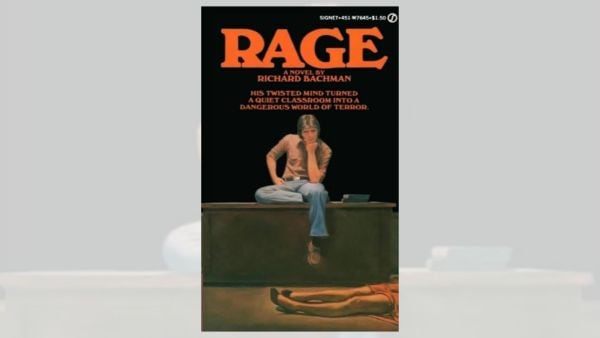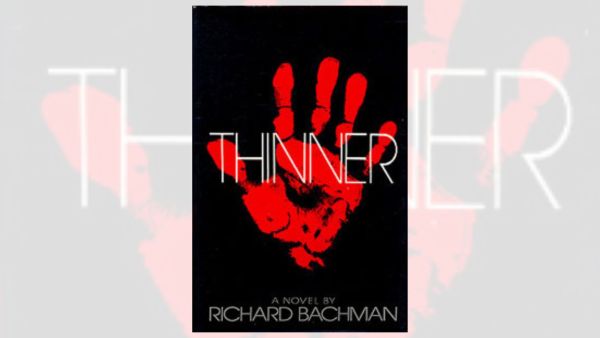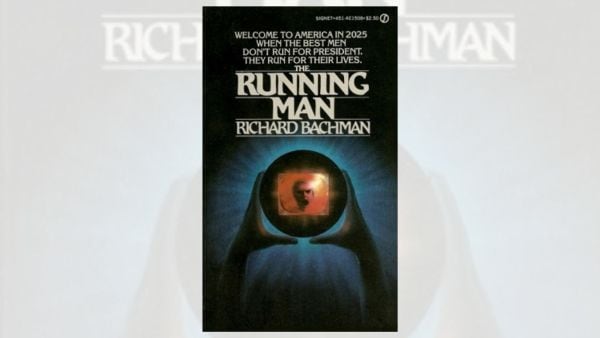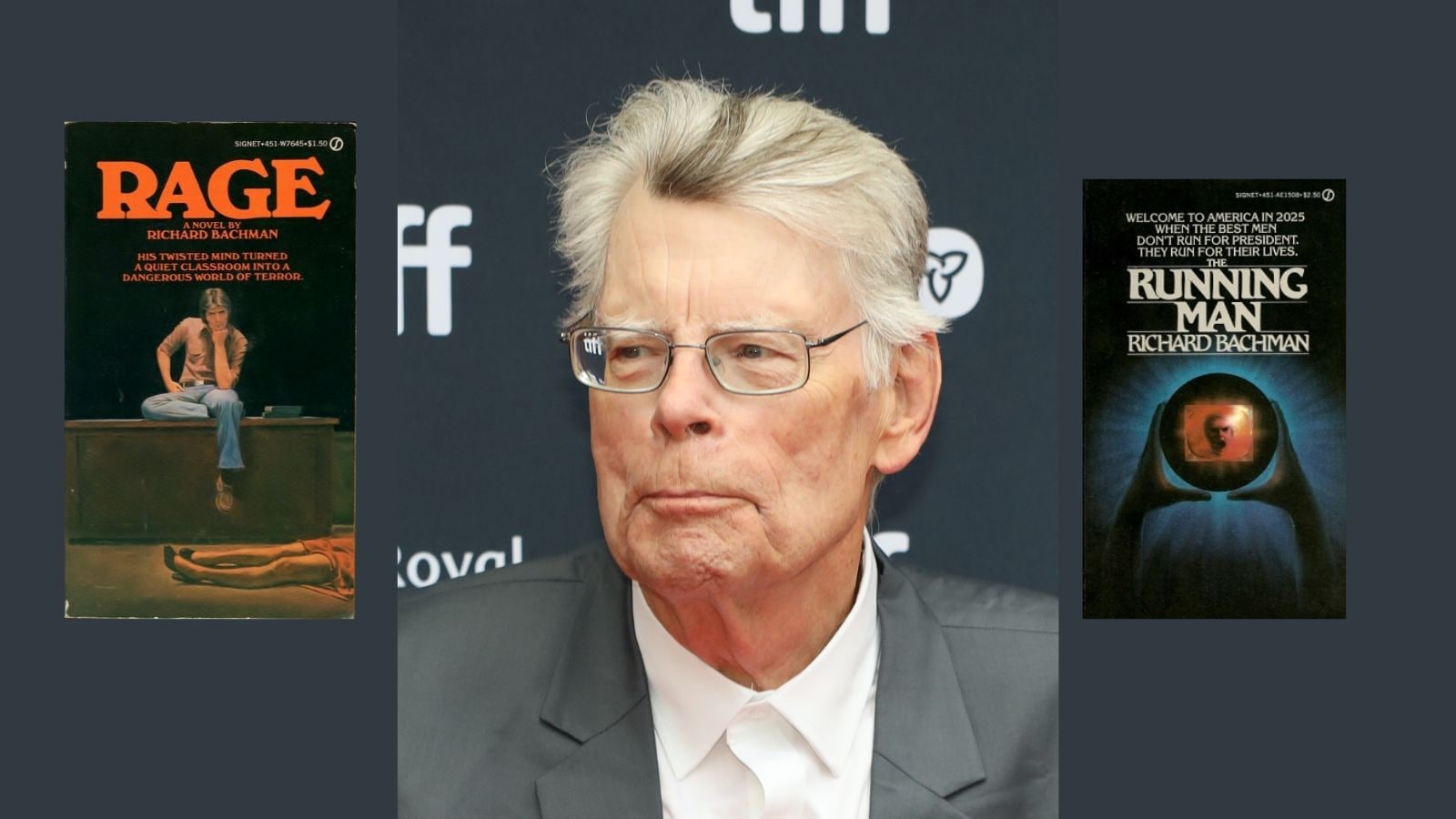The King of Horror, Stephen King went by the pseudonym Richard Bachman between 1977 to 1984. Why the pseudonym? To publish more novels in a year as publishers at that time preferred releasing just one or two books in a year by an author. King wrote several novels under this pen name, and delved into some dark themes, veering from his forte, the supernatural.
His works, such as The Shining, It, and Carrie, are widely successful and have been adapted for the screen. Here are some of the novels Stephen King wrote using his Bachman persona:
Story continues below this ad
1. Rage (1977)
 First of the novels written under the Richard Bachman pseudonym. (source: amazon.in)
First of the novels written under the Richard Bachman pseudonym. (source: amazon.in)
Sadly, school shootings have made the headlines enough times, especially in America, for everybody to be aware of it. Why do teenagers get so violent? What makes them killers at such a young age? Experts will tell you, it is anger directed towards society, authorities, and bullies.
In a vicious circle, such incidents have inspired many works of literature, which in turn have inspired school shootings. Rage by Richard Bachman is one such work surrounded in controversy as it gained notoriety for inspiring a few school shootings. The book is focused on one Charles Decker, a teenager, who assaulted his school teacher, killed another, and held his classmates hostage for a few hours. Written from the first-person perspective of Charles Decker, As authorities attempt conversing with him, bit-by-bit his childhood trauma is revealed through flashbacks and conversations.
Later, he book was perceived as a creed for school shooters as several shooting took place after reading it, after which King pulled the novel out of print to prevent his name from being further associated with the shootings. This, however, did not stop the shootings. Rage offers a peek into the culture of gun violence around the world, especially in America, prevalent among teenagers and how they view it as a solution to their misery.
2. Thinner (1984)
 A body horror tale of an unpleasant man and the curse he tries to lift off. (Source: Wikimedia commons)
A body horror tale of an unpleasant man and the curse he tries to lift off. (Source: Wikimedia commons)
This is the story of a haughty obese man, an accident, a gypsy curse, unexpected weight loss, death(s) and guilt. The protagonist is unlikeable, and the reader keeps hoping that they will make better decisions. It takes us on a rollercoaster of emotions: anger, misery, disappointment and lingering hope. It is a portal into a world where everything is not sunshine and rainbows.
Story continues below this ad
It is the story of a bigshot lawyer, Billy Halleck, not an endearing character to say the least. When his actions finally caught up with him, and all those who were unfortunate to associate with him, one waits for the remorse to settle in, but none is forthcoming. King exposes the feel-good myth that there is good in everybody.
3. The Long Walk (1979)
 A strange walking contest with no finish-line. (source: amazon.in)
A strange walking contest with no finish-line. (source: amazon.in)
This is a dystopian novel set in the United States of America where a strange annual contest is being televised for viewers’ entertainment. Hundreds of teenagers walk, accompanied by soldiers who constantly monitor their required speed (6.4 km/hour). Troublingly, there is no finishing line. The winner will be the last man walking. Whoever stops is executed. Why people are participating in the race? The winner gets carte blanche on what they want and can use it for the rest of their life.
The story follows one of the participating teenagers, Ray Garraty, 16, who joins the race and befriends other walkers who eventually perish. The race explores the psychological impact of being in a race constantly. It is a tale of endurance and companionship. In this dystopian world, death is a cinch and living is no walk in the park. The walkers’ comradery is but an illusion as at the end of the journey, there will only be one person walking. This is one of Bachman’s better written books and is being adapted into a film set to release in September 2025.
4. The Running Man (1982)
 A dangerous reality TV game show controlled by a ruthless regime. (Source: wikimedia commons)
A dangerous reality TV game show controlled by a ruthless regime. (Source: wikimedia commons)
It is the year 2025 in totalitarian America where reality TV is running several ‘dangerous’ games. The games are controlled by the state and are fatal. Yet, people willingly participate for the prize money. One contestant is Ben Richards, who needs the money to save his daughter’s life. So, he enters a game called ‘The Running Man’ where he has to run and hide from the police and trackers, people hired by the state to kill the participants. The entire game is televised so that viewers can disclose the participants’ location to the trackers.
Story continues below this ad
The book was adapted for film in 1987, starring Arnold Schwarzenneger. However, the plot somewhat deviated from the book. Another upcoming film is set to release in November 2025. The novel is terrifying given the time period it was written in, a time where the future seemed bleak. Ben Richards is the kind of man who would do anything for his family and so he enters the competition.
The book has all the features of a typical dystopian novel: political oppression, eroded morality, social instability, among others. It feels similar to Bachman’s other novel ‘The Long Walk,’ which has a similar plot of a dystopian society and reality TV game which is nothing short of cruel and brutal.
King was weary of 21st century America where the virtues of the world will turn to dust and the few people who have even a hint of goodness and resistance will be left to their devastating fate. The society becomes hopeless and the people helpless.
5. Blaze (1973)
 Richard Bachman’s Blaze is the story of a pitiable man with limited intellectual capability. (source: amazon.in)
Richard Bachman’s Blaze is the story of a pitiable man with limited intellectual capability. (source: amazon.in)
Blaze is not the sharpest tool in the shed. In fact, he was not sharp at all as he suffered physical abuse during his childhood which affected his cognitive ability. Now, he is a big body with a small brain. Blaze’s real name was Clayton Blaisdell Jr, and he was accompanied by his friend, George, who was the brains of the duo. But this balance did not last long as George died and Blaze started hallucinating him being alive. George, even in death, guides Blaze through his quests which were mainly unsuccessful heists.
Story continues below this ad
Blaze (as guided by George) kidnaps a baby in hopes of demanding ransom money from the billionaire parents. But as his twisted fate was written, his journey alone as a man with limited intellectual capability was an uphill battle. Readers might find Blaze pitiable due to his unstable upbringing, they might even root for him to succeed in his capers, but at the same time you would want him to get arrested.
(The writer is an intern with indianexpress.com)
